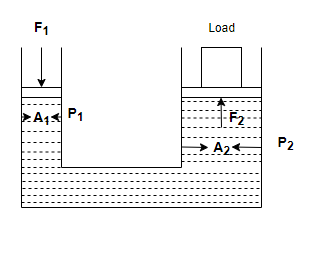Question
Question: A piston of cross-sectional area \(100 cm^2\) is used in a hydraulic press to exert a force of 107 d...
A piston of cross-sectional area 100cm2 is used in a hydraulic press to exert a force of 107 dynes on the water. The cross sectional area of the other piston which supports an object having a mass of 2000 kg is
(A) 100cm2
(B) 109cm2
(C) 2×104cm2
(D) 2×1010cm2
Solution
Hint:- The given problem can be solved by taking the consideration of hydraulic lift that is being used to lift the heavy loads. The working of hydraulic lift is based on Pascal’s law. Pascal’s law states that if gravity effect is neglected, the pressure at every point of liquid in equilibrium of rest is the same.
Complete step-by-step solution :

As given by the Pascal’s law pressure felt at every point of liquid that is being used in a hydraulic press will be same in equilibrium of rest i.e.,
P1=P2 -----(1)
Where P1= pressure at one point and P2= pressure at another point
We also know from Pascal’s law that the pressure increased using one piston will be communicated at each and every point in the liquid. Thus, the same pressure will act on the other piston.
Now given conditions are as below –
Cross-sectional area of piston 1 is A1=100cm2 or A1=0.01m2
Force on piston 1 is F1=107dynes or F1=100N
And force on piston 2 is equal to weight of the mass that is kept on the piston i.e., F2=M×g
F2=2000×10=2×104N.
Now, let us consider the cross-sectional area of piston 2 is A2=A
Step 2: Now we know from equation (1), that P1=P2
And pressure can be defined by force per unit area i.e., P=AF
So, A1F1=A2F2 keeping the values from above
⇒0.01100=A2×104on solving this equation further
⇒A=1002×104×0.01
⇒A=2m2 or A=2×104cm2
Hence, the correct option is (C).
Note:-
Pascal’s law also holds for the principle of transmission of pressure in liquids or gases. In this form, Pascal’s law states that the increase in pressure at one point of the enclosed liquid equilibrium of rest is transmitted equally to all other points of the liquid and also to the walls of the container, provided that the effect of gravity is neglected.
